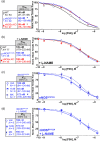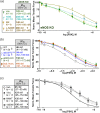Protein kinase A facilitates relaxation of mouse ileum via phosphorylation of neuronal nitric oxide synthase
- PMID: 31975425
- PMCID: PMC7236076
- DOI: 10.1111/bph.15001
Protein kinase A facilitates relaxation of mouse ileum via phosphorylation of neuronal nitric oxide synthase
Abstract
Background and purpose: The enteric neurotransmitter nitric oxide (NO) regulates gastrointestinal motility by relaxing smooth muscle. Pharmacological cAMP induction also relaxes gastrointestinal smooth muscle, but it is uncertain whether cAMP augments or suppresses enteric NO signalling. In other organ systems, cAMP can increase neuronal NO production by stimulating protein kinase A (PKA) to phosphorylate neuronal NOS (nNOS) Serine-1412 (S1412). We hypothesized that cAMP also increases nNOS S1412 phosphorylation by PKA in enteric neurons to augment nitrergic relaxation of mouse ileum.
Experimental approach: We measured contractile force and nNOS S1412 phosphorylation in ileal rings suspended in an organ bath. We used forskolin to induce cAMP-dependent relaxation of wild type, nNOSS1412A knock-in and nNOSα-null ileal rings in the presence or absence of PKA, protein kinase B (Akt) and NOS inhibitors.
Key results: Forskolin stimulated phosphorylation of nNOS S1412 in mouse ileum. Forskolin relaxed nNOSα-null and nNOSS1412A ileal rings less than wild-type ileal rings. PKA inhibition blocked forskolin-induced nNOS phosphorylation and attenuated relaxation of wild type but not nNOSS1412A ileum. Akt inhibition did not alter nNOS phosphorylation with forskolin but did attenuate relaxation of wild type and nNOSS1412A . NOS inhibition with L-NAME eliminated the effects of PKA and Akt inhibitors on relaxation.
Conclusion and implications: PKA phosphorylation of nNOS S1412 augments forskolin-induced nitrergic ileal relaxation. The relationship between cAMP/PKA and NO is therefore synergistic in enteric nitrergic neurons. Because NO regulates gut motility, selective modulation of enteric neuronal cAMP synthesis may be useful for the treatment of gastrointestinal motility disorders.
© 2020 The British Pharmacological Society.
Conflict of interest statement
The authors have no conflicts of interest.
Figures





Similar articles
-
Akt phosphorylation of neuronal nitric oxide synthase regulates gastrointestinal motility in mouse ileum.Proc Natl Acad Sci U S A. 2019 Aug 27;116(35):17541-17546. doi: 10.1073/pnas.1905902116. Epub 2019 Aug 12. Proc Natl Acad Sci U S A. 2019. PMID: 31405982 Free PMC article.
-
Cyclic AMP-dependent phosphorylation of neuronal nitric oxide synthase mediates penile erection.Proc Natl Acad Sci U S A. 2012 Oct 9;109(41):16624-9. doi: 10.1073/pnas.1213790109. Epub 2012 Sep 24. Proc Natl Acad Sci U S A. 2012. PMID: 23012472 Free PMC article.
-
Cyclic AMP-mediated upregulation of the expression of neuronal NO synthase in human A673 neuroepithelioma cells results in a decrease in the level of bioactive NO production: analysis of the signaling mechanisms that are involved.Biochemistry. 2004 Jun 8;43(22):7197-206. doi: 10.1021/bi0302191. Biochemistry. 2004. PMID: 15170357
-
Molecular mechanisms of neuronal nitric oxide synthase in cardiac function and pathophysiology.J Physiol. 2014 Aug 1;592(15):3189-200. doi: 10.1113/jphysiol.2013.270306. Epub 2014 Apr 22. J Physiol. 2014. PMID: 24756636 Free PMC article. Review.
-
Gender bias in gastroparesis: is nitric oxide the answer?Dig Dis Sci. 2011 Sep;56(9):2520-7. doi: 10.1007/s10620-011-1735-6. Epub 2011 May 11. Dig Dis Sci. 2011. PMID: 21559738 Free PMC article. Review.
Cited by
-
Effect of neuronal nitric oxide synthase serine-1412 phosphorylation on hypothalamic-pituitary-ovarian function and leptin response.Biol Reprod. 2020 May 26;102(6):1281-1289. doi: 10.1093/biolre/ioaa025. Biol Reprod. 2020. PMID: 32101284 Free PMC article.
-
Targeting Akt in cancer for precision therapy.J Hematol Oncol. 2021 Aug 21;14(1):128. doi: 10.1186/s13045-021-01137-8. J Hematol Oncol. 2021. PMID: 34419139 Free PMC article. Review.
-
Neural targets of the enteric dopaminergic system in regulating motility of rat proximal colon.Pflugers Arch. 2023 Nov;475(11):1315-1327. doi: 10.1007/s00424-023-02849-1. Epub 2023 Aug 17. Pflugers Arch. 2023. PMID: 37589734
-
Reassessing the role of nitric oxide in the pathogenesis of sphincter of Oddi dysfunction.Gastroenterol Rep (Oxf). 2025 Mar 5;13:goaf001. doi: 10.1093/gastro/goaf001. eCollection 2025. Gastroenterol Rep (Oxf). 2025. PMID: 40046950 Free PMC article. Review.
-
AKT kinases as therapeutic targets.J Exp Clin Cancer Res. 2024 Nov 29;43(1):313. doi: 10.1186/s13046-024-03207-4. J Exp Clin Cancer Res. 2024. PMID: 39614261 Free PMC article. Review.
References
-
- Alexander, S. P. H. , Roberts, R. E. , Broughton, B. R. S. , Sobey, C. G. , George, C. H. , Stanford, S. C. , … Ahluwalia, A. (2018). Goals and practicalities of immunoblotting and immunohistochemistry: A guide for submission to the British Journal of Pharmacology. British Journal of Pharmacology, 175(3), 407–411. 10.1111/bph.14112 - DOI - PMC - PubMed
Publication types
MeSH terms
Substances
Grants and funding
LinkOut - more resources
Full Text Sources
Molecular Biology Databases

